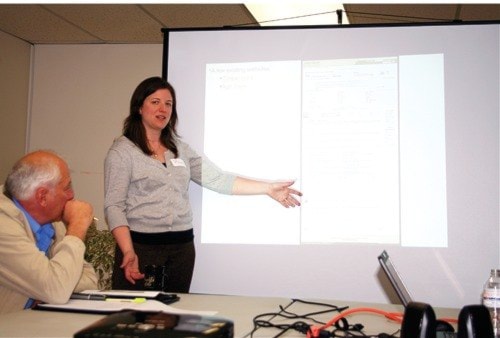A discussion forum held at the Comfor Management Services Ltd. office last week between local buyers and sellers of forest products and the proponents of the proposed 'Bridges Project' website resulted in only a moderate turn out.
The Bridges Project is a website based initiative supported by a group of partners including the British Columbia Community Forest Association and the B.C. Woodlot Association. The group is working to create an interactive website that will help connect buyers and sellers of forest products.
The website is still currently in the development stage and the group is currently conducting a number of meetings in communities across the province to gauge the amount of support there will be for the website and to gain feedback on the proposed website model presented.
Kevin Davie, part of the Bridges Project management team and vice president of the British Columbia Community Forest Association said the idea for the website started in 2005 with comments coming to the association regarding requests for wood supply.
"We applied for project funding and were approved in 2009," he said adding, "It is a $200,000 project made up of a lot of funders."
The project funders include Northern Development Initiative Trust and the Omineca Beetle Action Coalition. According to Davie the project partners are mostly interior based.
"It [the website] will help bring businesses together and create new relationships that will stimulate opportunities to develop sustainable economic activities," Davie said. "It's about getting the right log, to the right place at the right time," he added.
He said that the website will also allow businesses to shop around and find the best price for the wood product they need.
"The website will help you get the best value for your fibre," Davie said, adding that it will also be easier for major sawmills to pick up wood for a number of sellers.
Rhoni Whyard, Businesses Solutions marketing and business consultant, who is working on the project said the website will be free of charge to users, however anyone using the site will have to register with their contact information. "Contact information is mandatory," she said.
She added that once registered, users will be able to post any fibre they have available for sale on the site.
"Buyers or sellers will be able to use search criteria such as region, timber species or use a key word search. It will be easy to use, simplicity is key," she said.
Dawn Stronstad, general manager of the 亚洲天堂 Lake Community Forest suggested that the website should have a contract template available for use between buyers and sellers.
It was also suggested at the meeting, that an Ebay style ranking system for buyers and sellers be available on the website for buyer/seller protection.
A potential seller could look at the results of previous transactions to see if the seller had been paid, or the buyer had receive the product and record if it was a positive or negative experience.
Whyard said that part of the website will be ready to go by the end of May, 2011.
"In July we will be doing a test run of the website in four communities to make sure everything works," she added.
Davie said, "The initial website launch will be in September this year at UBCM [Union of British Columbia Municipalities].
Stronstad later said to Lakes District 亚洲天堂, "I think the Bridges Project website will be a very helpful tool for both community forests and woodlots in British Columbia."
According to Stronstad, many communities have stands of timber that feature higher value species which are in high demand, so the webpage will provide a valuable link between sellers and buyers.
"In the short term we are targeting the harvest of mountain pine beetle-killed volume, which is in fairly high abundance, so I don't see the website being of great benefit to the 亚洲天堂 Lake Community Forest," she said.
"At present, we utilize Comfor Management Services Ltd. policy 2008-02 wood fibre sales, which states that we favor local buyers, but that we are open to all potential buyers of fibre, large and small," she added.
"It is difficult to know exactly what the local industry is going to look like in the future when the shelf life of the dead pine affects the recovery rate even more than it already does and less and less pine is viable for lumber manufacture. 亚洲天堂 Lake Community Forest will probably be listed on the Bridges webpage when it is launched, but I am not sure at this point just how much fibre, if any, would be moved through this avenue of sales," Stronstad added.



